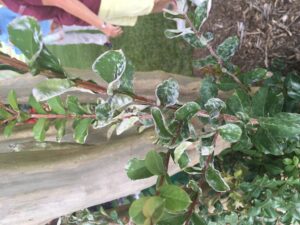How to control powdery mildew on Crape Myrtle

Wayne County Cooperative Extension offers several ways to control powdery mildew in crape myrtles.
WAYNE COUNTY — It is not a surprise this time of year to see diseases show up on some of our popular landscape plants. Crape Myrtles are known for being essentially trouble-free plants with little disease and few insect problems, but one problem that can occur is a disease called powdery mildew.
Powdery mildew is a disease which is common on many ornamental trees and shrubs, including crape myrtles. It is a powdery white to light gray-colored fungus that will grow on succulent stems, leaves, buds and flowers. Young plants and new growth are usually more severely damaged than older plants, leaves or branches. Flowers that are heavily infected may fail to open. Parts of the plant that are severely infected will usually look distorted and stunted.
Powdery mildew is a disease which is common on many ornamental trees and shrubs, including crape myrtles. It will also show up in shady, damp locations especially where plants are crowded and air circulation is poor. High humidity and rainy conditions are good environmental conditions for powdery mildew to occur.
The good news is there are several control measures that can be followed in order to prevent and treat powdery mildew. If you are getting ready to purchase a crape myrtle, you can immediately control powdery mildew by purchasing a resistant variety and avoiding susceptible varieties.
The level of resistance to powdery mildew varies for particular Crape Myrtles. Location and environmental conditions can also affect the level of resistance in some Crape Myrtle varieties. Some Crape Myrtle varieties will have good to excellent resistance to powdery mildew, while others will be very susceptible. When shopping for Crape Myrtles note the variety and check for the extent of resistance.
There are some cultural practices that will help reduce or prevent powdery mildew from occurring on Crape Myrtles. Be sure to remove sprouts (suckers) at the base of the plant as they occur. Since the sprouts are new growth, they are more susceptible to powdery mildew. Once these sprouts become infected, the fungus easily spreads to the upper portions of the plant.
Planting Crape Myrtles in the proper location will also help discourage powdery mildew. Crape Myrtles should be planted in a sunny location. Planting a crape myrtle in a shady location will not only encourage powdery mildew but shade will also reduce flowering.
When pruning a Crape Myrtle, thin the canopy so that you allow good air circulation throughout the tree. Good air circulation will allow the leaf surface to dry out more quickly after a rain and will reduce wet surfaces for powdery mildew to show up on. Pruning out severely diseased portions of the plant will also help reduce the disease if only a few parts are infected.
If the disease is severe enough, there are some chemical control options available. Available fungicides to control powdery mildew on crape myrtles and many other ornamentals include myclobutanil (Eagle, Immunox), triforine (Funginex), propiconazole (Banner Maxx) and triadimefon (Bayleton, Strike). When using fungicides, remember to read the label and follow directions.
— From the Wayne County Cooperative Extension website, by Extension Agent Jessica Strickland



